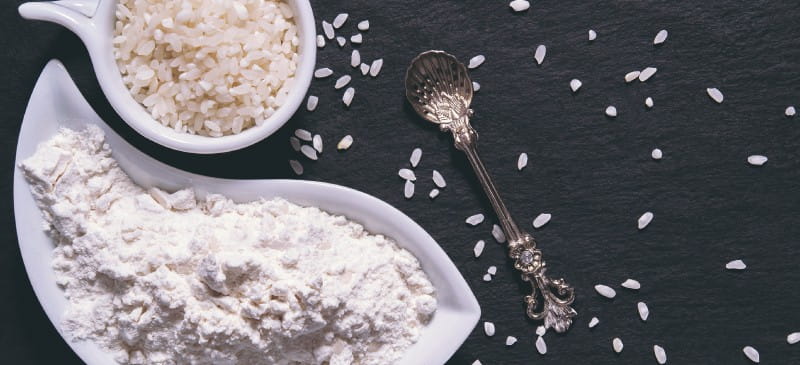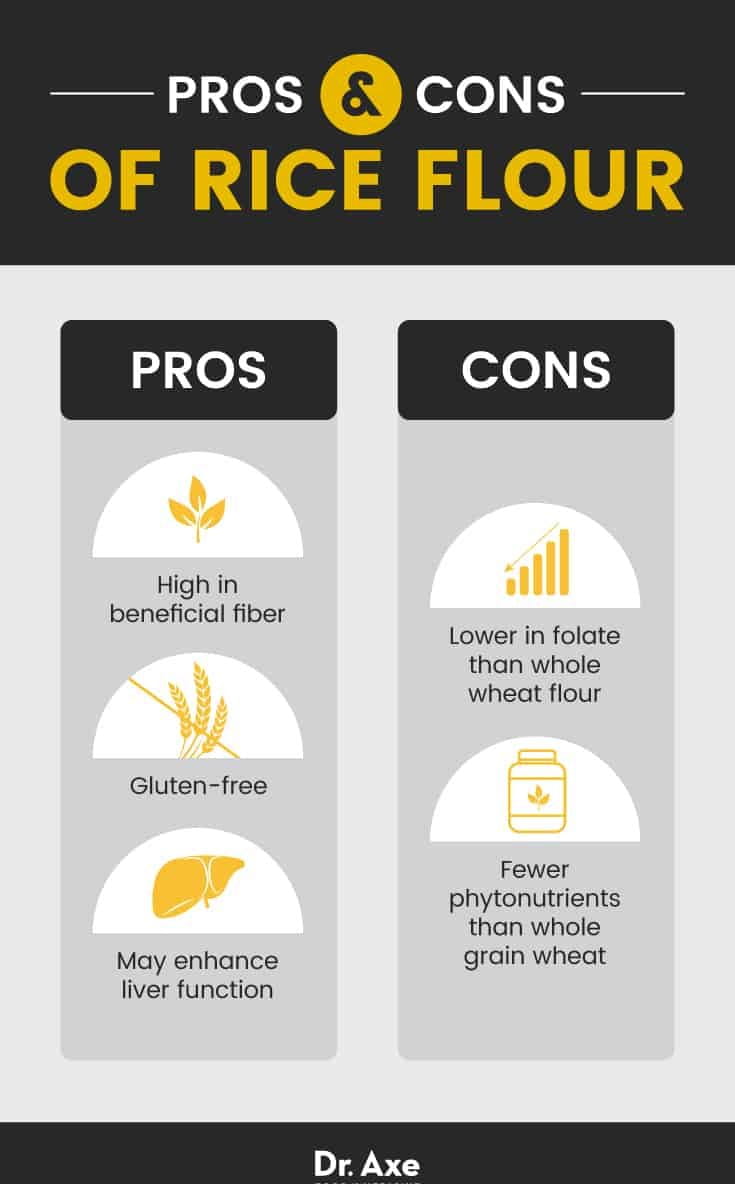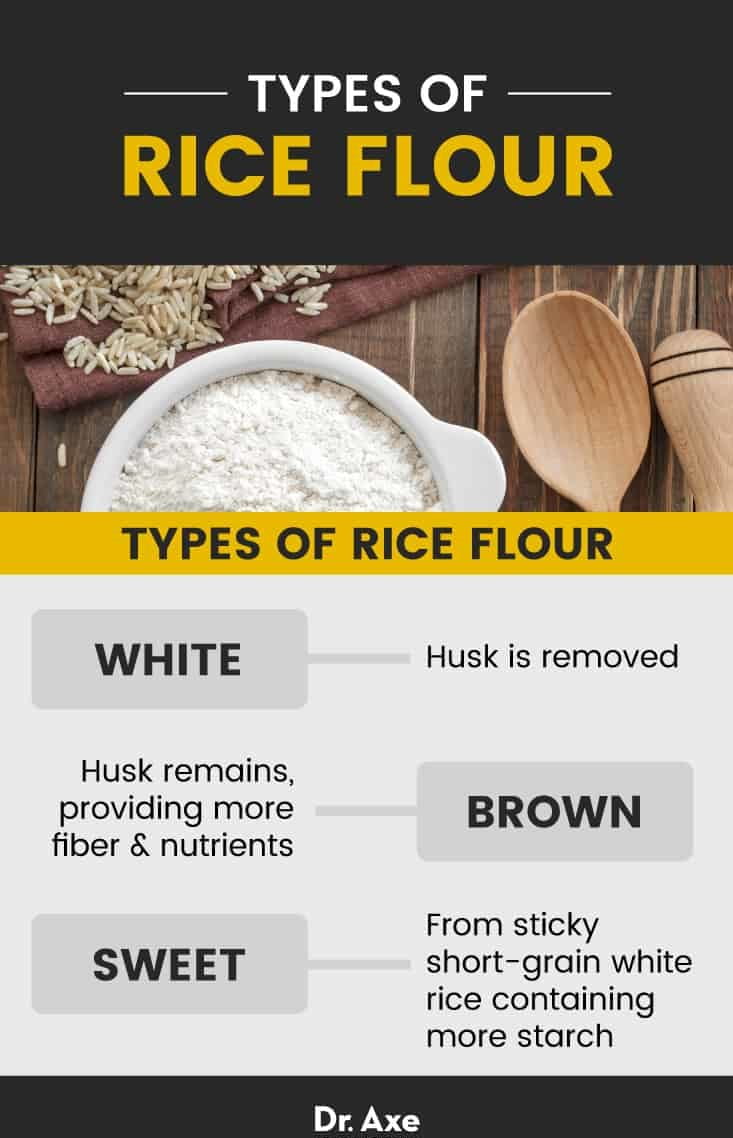Exploring the Benefits of Rice Flour
Is Rice Flour Good for You? Pros & Cons of Rice Flour Nutrition

If you’re looking to avoid wheat flour and/or gluten and aren’t sure where to turn, rice flour is an option for you. This gluten-free flour, also know as rice powder, is made from finely milled rice. It can be found in both white rice and brown rice forms, and it’s a staple food in Southeast Asia, Japan and southern India.
Rice flour is a great substitute for wheat flour, since most wheat flour contains gluten — a protein that can irritate the digestive system or worse for anyone who is gluten intolerant. Rice flour is a popular thickening agent because it has the ability to prevent liquid separation. It works great in soups, sauces and gravies and is often used to make crackers, cakes and dumplings.
But is rice flour good for you? That’s an excellent question. On the positive side, it’s high in fiber and may protect the liver, but it’s also lacking nutrition other flours might contain.
Is Rice Flour Good for You?
With the increasing need for gluten-free foods, rice flour can be a great choice. However, it’s important to understand that some foods may lack some nutritional value.
Many gluten-free bakery-type products provide less protein, fiber and mineral content, as well as an elevated glycemic index than some foods that contain gluten. However, by adding rice and buckwheat flour, egg white or whey protein, nutritional values can be enhanced.
At the same time, some studies show that the glycemic index of some of the latest gluten-free products has been greatly improved by adding mineral-dense ingredients, such as amaranth, buckwheat or flaxseed flour. (1)
Rice Flour Benefits
1. High in Beneficial Fiber
Our bodies need insoluble fiber to help rid themselves of waste, so if constipation is a problem, rice flour — in particular brown rice flour — may help along with nuts, beans and vegetables, such as cauliflower and potatoes — all foods that provide plenty of fiber.
Choosing a high-fiber diet not only helps the body by eliminating waste, but it may help lower cholesterol and keep blood sugar levels in check. It may even help minimize the risk of diverticular disease, colon diseases, type-2 diabetes and hypertension. (2)
2. Great Gluten-Free Option
Rice flour is made from a gluten-free grain, which may make it the better choice when it comes to anyone suffering from gluten intolerance and Celiac disease. Gluten is a protein found is grain products, such as wheat and rye.
Anyone with Celiac disease suffers from a digestive condition that disrupts the immune system when coming in contact with gluten. For those with an intolerance, albeit mild, it still aids in the digestive process if avoided. Rice flour can help by offering an alternative. (3)
3. May Help Maintain Healthy Liver Function
Rice flour contains choline, which helps transport cholesterol and triglycerides from the liver to wherethey’re needed within the body. Therefore, choline may help you maintain a healthy liver.
Choline is required to maintain essential components of the membranes. Hepatocellular carcinoma is a cancer the stems from chronic liver disease, and rates are rising. A study published in the International Journal of Experimental Pathology reported that a diet that is deficient in choline and high in fat showed rapidly progressive liver fibrosis in mice. (4) Because rice flour contains choline, it may be a great choice to keep the liver in a healthy state.

Rice Flour Drawbacks
- Less folate
- Fewer phytonutrients
1. Contains Less Folate than Whole Wheat Flour
While both whole wheat flour and rice flour contain similar nutritional values, whole wheat flour has rice flour beat when it comes to folate. These grains run a close race as far as thiamine, niacin and riboflavin, and they both contain vitamin E, but whole wheat offers 14 percent of the daily recommendation of folate.
Folate is important since it helps remove homocysteine from the blood. This process may lower the risk of cardiovascular disease. Wonder why folate is so critical during pregnancy? It’s essential for the development and growth of new cells, which is beneficial during the growth pregnancy. (5)
2. Has Fewer Phytonutrients than Whole Grain Wheat
Both rice flour and whole grain wheat flour provide important cancer-fighting phytonutrients called lignans, but whole grain wheat flour has 30 percent more. Lignans can help balance out estrogen levels in the body. Foods that contain lignans may help lower the risk of cardiovascular disease, cancer and reduce cholesterol levels.
Related: Rice Cakes: Are They Healthy? Pros, Cons + How to Use
Nutrition Facts
There are three types of rice flour: brown rice flour, sweet rice flour and white rice flour. Interestingly, the white rice stems from the brown rice. This occurs when the husk is removed.
A health benefit to having the brown rice version is that the husk remains intact, which provides more fiber and nutritional value, such as increased calcium and zinc. Brown rice flour has a nutty flavor and works best when combined with other flours to help avoid a crumbly, dry texture.
Sweet rice flour comes from sticky short-grain white rice, containing more starch than white rice or brown rice, and is often used in Asian foods. Though all three can act as thickening agents, the sweet rice version may be a better choice given its sticky-like, starchy contents.
One cup (158 grams) of white rice flour contains about: (6)
- 578 calories
- 127 grams carbohydrates
- 9.4 grams protein
- 2.2 grams fat
- 3.8 grams fiber
- 1.9 milligrams manganese (95 percent DV)
- 0.7 milligram vitamin B6 (34 percent DV)
- 23.9 microgram selenium (34 percent DV)
- 4.1 milligrams niacin (20 percent DV)
- 0.2 milligram thiamin (15 percent DV)
- 155 milligrams phosphorus (15 percent DV)
- 55.3 milligrams magnesium (14 percent DV)
- 1.3 milligrams pantothenic acid (13 percent DV)
- 0.2 milligram copper (10 percent DV)
- 1.3 milligrams zinc (8 percent DV)
One cup (158 grams) of brown rice flour contains about: (7)
- 574 calories
- 121 grams carbohydrates
- 11.4 grams protein
- 4.4 grams fat
- 7.3 grams fiber
- 6.3 milligrams manganese (317 percent DV)
- 1.2 milligrams vitamin B6 (58 percent DV)
- 532 milligrams phosphorus (53 percent DV)
- 10 milligrams niacin (50 percent DV)
- 0.7 milligram thiamin (47 percent DV)
- 177 milligrams magnesium (44 percent DV)
- 3.9 milligrams zinc (26 percent DV)
- 2.5 milligrams pantothenic acid (25 percent DV)
- 0.4 milligram copper (18 percent DV)
- 3.1 milligrams iron (17 percent DV)
- 457 milligrams potassium (13 percent DV)
- 1.9 milligrams vitamin E (9 percent DV)
- 0.1 milligram riboflavin (7 percent DV)
- 25.3 microgram vitamin B12 (6 percent DV)

Rice Flour vs. Other Flours
Rice flour contains less yeast, which may mean that, when baking, you will need more baking soda. White rice flour has a silky smooth texture and a very white color, which makes it stand out from others. It can be found in Asian markets and natural food stores, but if you have a coffee grinder or high-powered blender, you can simply make your own.
For the most part, rice flour can be interchanged with all-purpose white flour with very little difference since they perform the same way when used in cooking. Both rice flour and all-purpose flour are great as thickening agents for soups, sauces, gravies and roux.
There are tons of other flours available, such as pea flour, chickpea flour, coconut flour, amaranth flour, arrowroot flour, quinoa flour, carob flour, einkorn flour and even nut flours. Basically, you can grind most any dry ingredient into a flour, but is it good for baking? For example, chia seeds can be formed to make chia flour, but does it work as well as rice flour. Not so much. While chia flour can be used for many products, baking may not be one of them.
Research has found that baking with chia flour produced successful results. However, when using a lesser amount combined with rice flour, the results fared far better. Specifically, using no more than 14 percent whole chia flour to a rice flour-based, gluten-free bread will provide better texture and moisture to the bread while using more will start to diminish the quality. The good part is that chia flour, like many other flour options, can enhance the nutritional value by increasing the levels of ash, lipid, protein and dietary fiber as well as providing many other nutrients. (8, 9)
Recipes
Rice flour is not difficult to find and can be purchased at most grocery stores and health food stores. You can buy it in individual bags or in bulk. Asian specialty stores also have rice flour.
Making rice flour is easy! All you have to do is place the rice in a high-powered blender or food processor and grind it to a flour-like consistency. Another option is a grain grinder. A grain grinder will grain wheat, rice, oats, barley, quinoa and other small, hard dry grains with the ability to adjust it for coarse or fine textures. As far as savings, you will likely save about 50 percent versus buying it pre-ground.
There are many recipes that can utilize rice flour. Try this one to start:
Gluten-Free Curry Cauliflower Florets
INGREDIENTS:
- 1 pound cauliflower florets
- 3–4 tablespoons brown rice flour
- 2 eggs
- 1 tablespoon nutritional yeast flakes
- 1/2 teaspoon onion powder
- 1/2 teaspoon granulated garlic
- 1 pinch curry
- 1 pinch ground turmeric
- 1 teaspoon paprika
- Salt and pepper to taste
- Olive oil spray
DIRECTIONS:
- Preheat the oven to 450°F. Spray a rimmed baking sheet with olive oil. Set aside.
- In a bowl, beat the eggs. Set aside. In another bowl, combine the rice flour, nutritional yeast, curry, turmeric, onion powder, garlic, salt and pepper.
- Drop the cauliflower pieces into the egg mixture and coat them evenly. Shake off excess egg, then place them into the dry mixture. Coat them well with the dry mixture. Place the coated pieces on the baking sheet and repeat with the rest of the cauliflower.
- Spray the top of the cauliflower pieces with a light coating of olive oil. Bake for about 20–25 minutes until the pieces are tender. Flip the pieces over about halfway through. Serve while warm.
You can also try this Gluten-Free Brown Rice Flour Brownies recipe.
History
Rice has been around for a very long — some think as far back as 5000 B.C. with its beginning in China. Cultivation quickly spread making its way to Greece and the Mediterranean, then Southern Europe and North Africa. It continued to spread through Europe to Portugal, Brazil, Spain and South America. (10)
In the United States, southern states developed the rice trade on the many rice plantations around Georgetown, Charleston and Savannah, with the predominant strain of rice in the Carolinas coming from Africa and known as “Carolina Gold.”
Rice is important to many cultures, including the intention of ensuring fertility in marriage — one reason why rice is often thrown at weddings. Rice has almost been a staple for children as their first solid food. (11)
It’s hard to pinpoint exactly when rice flour became a form of flour, but it has long been known as an ingredient for rice noodles and Japanese desserts.
Risks and Side Effects
Rice is typically easy to digest and can be a part of a healthy diet. Recent controversy has been presented in regard to arsenic in rice. In general, if you have concerns, consider using a blend of flours to help reduce overconsuming rice flour. If you suspect problems relating to arsenic or seem to have digestive issues, stop consuming it immediately and make sure to seek professional help from your doctor.
Final Thoughts
Rice flour can be a great alternative to your diet, especially if you are gluten-intolerant or have Celiac disease. Experiment with different recipes to see what works best. Also, keep in mind that you may lose a few nutrients, but overall, rice flour is a safe and delicious alternative.
On the plus side, rice flour is gluten-free, high in fiber and can help protect your liver. On the downside, it’s lower in nutrients and phytonutrients than other flowers and also relatively high in carbs and calories.
If you want a gluten-free alternative to wheat flour, give rice flour a try, but also remember to check out other gluten-free flour options, such as coconut flour, sprouted flour, oat flour, almond flour, tapioca flour, chickpea flour, sorghum flour, cassava flour, amaranth flour, buckwheat flour, teff flour or even cricket flour.





Leave a comment